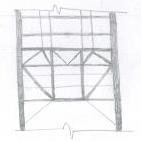Search the Community
Showing results for tags 'stiffness modifiers'.
-
Hi, I need to provide pick up columns to support the landing beam of staircase. The story-level beams will also rest on these columns. The stiffness modifiers prescribed for columns by ACI is 0.7. I was wondering if I can reduce that to (say) 0.35 or less, since I don't want these columns to participate in resisting bending moments as much as the 'actual' columns. Note that their primary purpose was to support the staircase landing beam, so designing them on gravity only load should be fine? Also, any thoughts on providing a pick up shear wall with f12 stiffness modifier = 0.0001 i.e. not letting it participate in lateral shear resistance? Thanks. Best, Wajahat
-
As salamu alikum, I have a query related to concrete design. We know that the stiffness modifiers should be considered only for the structural analysis. My query is during designing concrete members (beam and column) which modifiers should we use? Can we use full gross section (Ig=1.0) or same Ig as like analysis (e.g.- column- 0.7Ig,beam-0.35Ig) or 1.4 times the cracked section (e.g. for example column=0.7x1.4=0.98, beam=0.35x1.4=0.49)? I am too much confused about stiffness modifiers. Please let me know the right procedure to use stiffness modifiers. Thanks in advanced
-
The stiffness modifier for beams = 0.35I column = 0.7I and slabs 0.25I. they are required to consider the cracking of the members. my question is why do we consider 35% of stiffness for beams while code says we can use 70% of stiffness for columns? what is the significance of the numbers 35 , 70 , 25??
-
Hello, I need to know please what will be the stiffness modifiers values in ETABS for fully prestressed beam or slab in case of: - Wind Analysis - Earthquake Analysis Thank you in advance.
-
Hello I have a question regarding stiffness modifiers in ETABS. The code(ACI318) specifies us to use stiffness modifiers for walls column etc. What if I use 0.35 as stiffness modifier and not 0.7. What is the effect.I know that we have these stiffness modifiers based upon cracking of section and using these modifiers results in lesser stiffness thereby reductions in attraction of lateral forces.But suppose I want to reduce the lateral forces on walls therby using stiffness modifiers 0.35 for walls and not following the ACI. Thanks
-
what should we take moment of inertia of shear walls either cracked or uncracked section?
-
I want to comment on some modelling issues in ETABS. Though some of these things are discussed elsewhere in the forum, I hope to extract some more useful conclusions. First thing is related to modelling the bending stiffness of flexural members, for strength level loads, that is representative of their condition near failure. The ACI code specifies the modifier of 0.35 on gross moment of inertia to represent its condition at yielding. Some people say that the factor should be multiplied by 2 to represent the stiffness of T-beam. This approach would be justified if you are not taking into the account the out of plan bending stiffness of slab. But, ETABS does include the out of plane bending stiffness if you have modelled the slab by using shell elements. So, a factor of 0.7 would overestimate the stiffness of your structure in this case, and will lead to under-design. If one has used the modifier of 0.35 in ETABS for beams in beam-slab floor system, then what value should be adopted for slab? It should not be 0.25, as this value has been specified for flat plates and flat sab floor system. If one is using some value of modifier for out of plane bending stiffness on shells, then the share of the bending moment in beams will be reduced accordingly. This approach is correct if one will be providing the reinforcement in column strips of slab. But, if you are providing reinforcement in slab in the direction perpendicular to supports only, i.e. beams, as is the general practice in Pakistan, then you are under-estimating the flexural demand in beams. Now, there is also a question of factors to be used while deciding the amount of reinforcement required in beams, columns and shear walls. If you are using factors 0.35 for beams and shear walls, and 0.7 for columns, then you are finding out the demand in members at the point of yielding, and this conforms to the code. But, this also means that the structure might experience unacceptable cracks widths. So, if you are using 0.35 for calculating the demand at strength-level forces, then you should also perform crack-control-check at service-level loads by using the factor of 1. If you are calculating the strength-level demand with a modifier of 1 for all structural members, after you have decided the location and the number of shear walls with modifier of 0.35, then you are overestimating seismic forces, as you are underestimating the time-period. But, the structural performance will improve.
- 5 replies
-
- stiffness modifiers
- baz tips
-
(and 1 more)
Tagged with:
-
*Comments/Observations regarding modelling in ETABS* *Doc No: 10-00-CD-0006* *Date: May 06, 2017* Some of the observations made during extraction of results from ETABS (v 9.7.4), for design of reinforced concrete members, are being share in this article., 1) Minimum Eccentricity ETABS always considers the minimum eccentricity for selecting the design moment of columns irrespective of the probable behavior of the column, whether short or long column. See section 10.10.6.5 and its commentary of ACI 318-08 which deals with minimum eccentricity of long columns. You should always check the design moments that ETABS uses for columns if you want to bring down the cost of construction. 2) Unbraced/ Braced Preference If your model has lateral loads, ETABS will give you design moments in column irrespective of its status as braced or un-braced as per ACI 318 criteria. You should investigate if the storey under consideration is braced, or un-braced (10.10.5.2), and decide appropriate design moments of columns. 3) Time Period ETABS has a tendency to select a time period of the building that is considerably less than the value obtained by the approximate method, Method A, of the section 1630.2.2 of UBC 97. To quote the FEMA 451 document: ''Because this formula is based on lower bound regression analysis of measured building response in California, it will generally result in periods that are lower (hence, more conservative for use in predicting base shear) than those computed from a more rigorous mathematical model". So, there is no need to use the value of time period that is lot less than Ta. One should always check the time period used by the software; ETABS can overestimate the seismic force by more than 2 times. Method A gives lower T and higher V, so FEMA 451 has advised not to use the value of time period less than this value even if rigorous analysis gives a lower value. I have seen the results where Etabs have use the value of time period less than Ta; in-fact as low as 0.5Ta, which can increase the base shear two times. (For a complete discussion on time period, please see the following this thread that complements this section). 4) Stiffness Modifiers First thing is related to modelling the bending stiffness of flexural members, for strength level loads, that is representative of their condition near failure. The ACI code specifies the modifier of 0.35 on gross moment of inertia to represent its condition at yielding. Some people say that the factor should be multiplied by 2 to represent the stiffness of T-beam. This approach would be justified if you are not taking into the account the out of plan bending stiffness of slab. But, ETABS does include the out of plane bending stiffness if you have modelled the slab by using shell elements. So, a factor of 0.7 would overestimate the stiffness of your structure in this case, and will lead to under-design. If one has used the modifier of 0.35 in ETABS for beams in beam-slab floor system, then what value should be adopted for slab? It should not be 0.25, as this value has been specified for flat plates and flat sab floor system. If one is using some value of modifier for out of plane bending stiffness on shells, then the share of the bending moment in beams will be reduced accordingly. This approach is correct if one will be providing the reinforcement in column strips of slab. But, if you are providing reinforcement in slab in the direction perpendicular to supports only, i.e. beams, as is the general practice in Pakistan, then you are under-estimating the flexural demand in beams. Now, there is also a question of factors to be used while deciding the amount of reinforcement required in beams, columns and shear walls. If you are using factors 0.35 for beams and shear walls, and 0.7 for columns, then you are finding out the demand in members at the point of yielding, and this conforms to the code. But, this also means that the structure might experience unacceptable cracks widths. So, if you are using 0.35 for calculating the demand at strength-level forces, then you should also perform crack-control-check at service-level loads by using the factor of 1. If you are calculating the strength-level demand with a modifier of 1 for all structural members, after you have decided the location and the number of shear walls with modifier of 0.35, then you are overestimating seismic forces, as you are underestimating the time-period. But, the structural performance will improve. This article is based on my two separate posts regarding the subject matter. You can view the discussion on the items raised above by viewing the following links: 1) http://www.sepakistan.com/topic/2008-issues-in-etabs-results/ 2) http://www.sepakistan.com/topic/2290-modelling-issuesconsideration-in-etabs/ Thanks.
-
- stiffness modifiers
- time period etabs
- (and 3 more)
-
aslamwalekum , when we design reinforced concrete elements , for beam we take 0.35 , for column and wall we take 0.7 and for slabs we take 0.25 as modifiers , but i read in aci that for servicibilty analysis these modifiers has to increase by 43% which means for beam it become 0.5 , for column and shear walls it become 1.0 and for slab it become 0.35 , by doing this model drift and deflection both reduce to almost half of its original value. one thing more when we do manual check we dont take crack sections , for e.g for simply supported beam the deflection is 5\384 WL^4\EI , here the I (inertia ) is not the for the crack section ,its for the uncracked section , so what modifiers should be use 0.35 or 0.5 or 1.0
-
Hi, i am a fifth year student working on my final project, it is a 59 floors + basements tower. I am having a weird problem; after applying the stiffness or property modifiers (0.35 for beams and walls, 0.7 for columns and 0.25 for slabs), i got an instability warning during analysis. After several trials i found out that the problem is from the modifiers of the slabs, the other elements don't give me any warnings. So i tried to change the value of the 0.25 modifier and increased it to 0.35 (or higher) and after that i didnt get any warning messages. Is it normal or logical to get an instability warning below a certain value for a property modifier? or there is another problem related to something else and appears when i do this adjustment ?? i still cant use the 0.25 modifier for the slabs (for m11 m22 and m12). Any help is appreciated a lot. Thanks.
-
Hi; In ETABS model for designing columns and shear walls(because slabs will be desined on SAFE), I want to reduce m11=m22=m12=f11=f22=f22=0.25 Can I? (Semi rigid diaphragm assigned) thats because I want to design the building at same model for temperature and seimic and wind loads.
-
As beam Moment of inertia is 0.35 as per ACI code . if we taking it 35% then where is rest of 65% going ? Kindly give me concept of it , Similarly in Column we are taking it 70% what about remaining 30% ?






